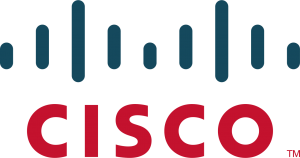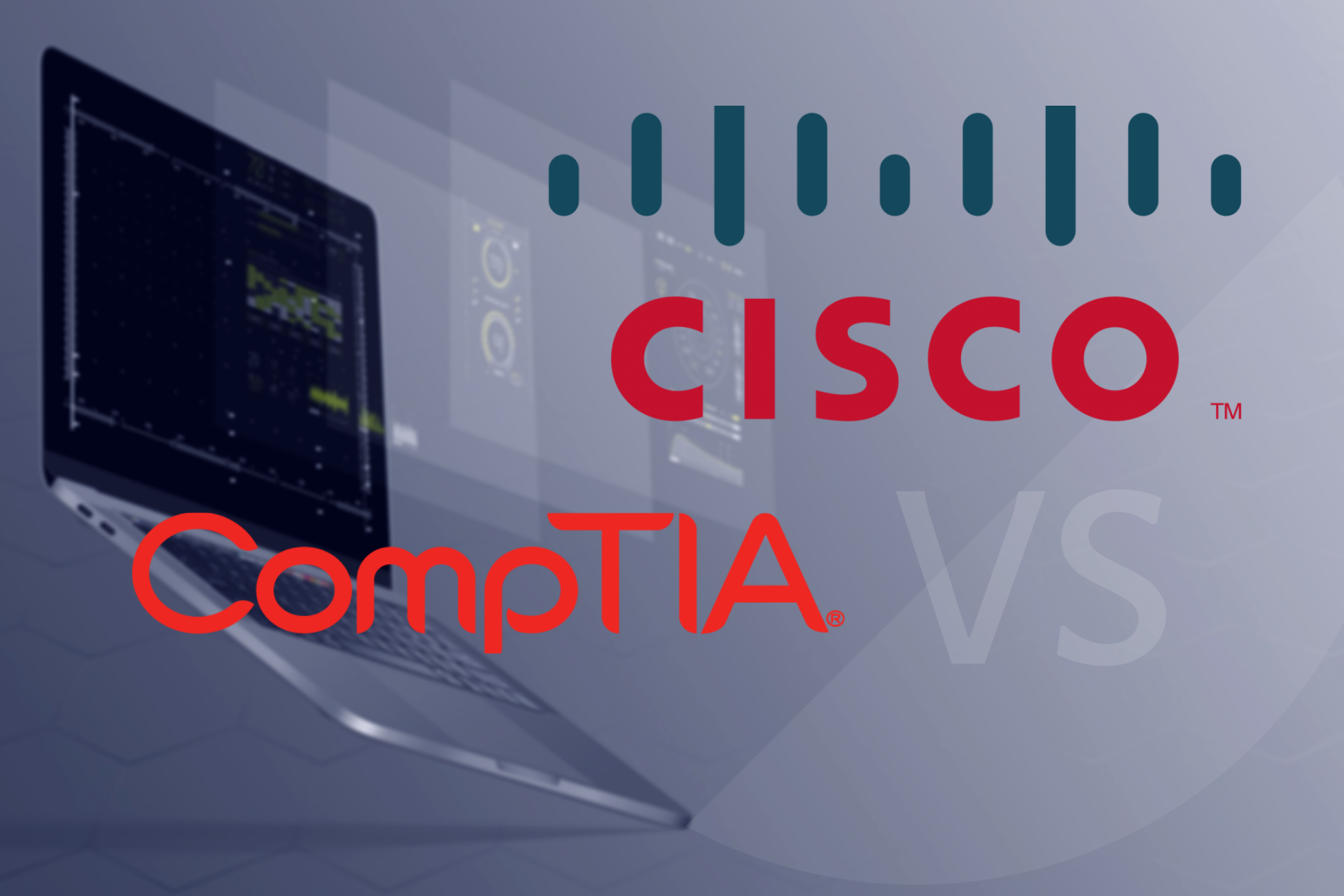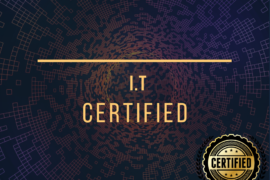An Introduction to CompTIA and Cisco
When looking to break into the field of networking or aspiring to obtain a networking certification, the two most popular entry-level certifications are Cisco CCENT and CompTIA Network+.
What is CISCO?
CISCO is a company based in San Jose, California in the USA involved in the manufacturing, designing, and selling of Network Equipment. It has grown from its inception in 1984 to become the most significant networking company in existence. CISCO was added to the NASDAQ stock exchange in 1990 after going public, and in by the year, 2000 became the world’s most marketable company, showing a market capitalization of over $500 billion.

The certifications attainable from CISCO include:
• CCENT
• CCT
• CCNA Routing and Switching
• CCDA
• CCNA Cloud
• CCNA Collaboration
• CCNA Data Center
• CCNA Security
• CCNA Service Provider
• CCNP Routing and Switching
• CCDP
• CCNP Collaboration
• CCNP Data Center
• CCNP Security
• CCNP Service Provider
• CCNP Wireless
• CCIE Routing and Switching
• CCDE
• CCIE Collaboration
• CCIE Data Center
• CCIE Security
• CCIE Service Provider
• CCIE Wireless
• CCIE Routing and Switching
• CCDE
• CCIE Collaboration
• CCIE Data Center
• CCIE Security
• CCIE Service Provider
• CCIE Wireless
What is CompTIA?
CompTIA (Computing Technology Industry Association) is a non-profit trade association that was formed in 1982. The organization is vendor-neutral and provides certifications in the IT industry. It was at first known as the Association of Better Computer Dealers, but the name was later changed to better imply the company’s ever-changing role in the computer industry.

The organization’s increase saw them eventually include subjects such as networking, imaging, mobile computing, UNIX. In 2010, CompTIA launched the “Creating IT Futures” ambition which sees them offering IT training to individuals with a lower income and veterans returning from their military duties.
Their certifications currently available from CompTIA include:
• A+
• Network+
• Security+
• CASP
• Server+
• CTT+
• Linux+
• Project+
• Cloud+
Understanding Cisco CCENT
CISCO CCENT is the first of two exams that can be passed for the student to earn their CCNA (Cisco Certified Networking Associate) certification. The review relating to CISCO CCENT is called ICND1 (Interconnecting Cisco Networking Devices Part 1).
This exam will consist of the following topics:
Explain the operation of data networks:
The student will be required to identify the functions of different network devices and to select the correct components to meet the network’s specifications. Use the protocols of TCP/IP to explain the flow of network data, explain what common web applications and networking applications are.
Implement a small switched network:
Use the correct equipment to network devices, interconnect switches, network devices, and hosts and describe media access control and technology for Ethernet types. Describe what network segmentation is, describe the operation of CISCO switches and their necessary operation, perform initial switch operations and save, and verify them. Work through hardware failures on switched networks.
Implement an IP addressing scheme and IP services to meet network requirements for a small branch office:
Create and execute an addressing scheme to a network, assign and verify IP addresses for hosts, networking devices and servers on a Local Area Network. Describe what DNS operations are and validate them, configure, test and troubleshoot DHCP and DNS on a router and identify and remedy IP address problems.
Implement a small routed network:
Describe what the basic concepts of routing are, explain the basic operation of CISCO routers, interconnect routers with networking devices using the correct equipment, connect, configure, and verify device interface operational status. Verify the device configuration using commands and utilities and ascertain the state of the network and router operation.
Explain and select the appropriate administrative tasks required for a Wireless LAN (WLAN):
Define the standards of wireless media, describe the various components of a small wireless network, specify the parameters and configuration needed for devices to connect to the right areas on a wireless network and identify common issues with wireless networks.
Identify security threats to a network and describe general methods to mitigate those threats:
Describe common network security threats and how the correct security policy helps defend against them. Describe what the best security practices to follow in securing network devices.
Implement and verify WAN links:
Describe what the different methods are to connect to a Wide Area Network, configure an essential WAN serial connection and check that network.
Understanding CompTIA Network+
CompTIA Network+ has a much broader view of networking than CISCO does, but takes a lighter approach in their topics. The topics that are included in the CompTIA Network+ course include the following:
Network Technologies:
services including TCP/IP suite, Networking protocols default TCP, and UDP port numbers, addressing formats for IPv4, IPv6, and MAC addressing, discussing addressing technologies (subnetting, CIDR, supernetting, NAT, and PAT), a discussion on routing, and a reviewing wireless communication standards, authentication, and encryption.
Network Media and Topologies:
Standard cable types and their properties including transmission speeds, distances, duplexing, noise immunity, and frequencies; cable connector types and common physical network topologies (star, mesh, bus, ring). Various wiring standards, LAN and WAN technology types, and properties plus wiring distribution systems and components.
Network Devices:
Includes the range of networking equipment like hubs, network interfaces, modems and media converters, switches, wireless access points, routers, firewalls, etc. Functions of specialized networking devices. There is a broader focus on switch details such as virtual LANs and port mirroring.
Network Management:
An explanation of management at the seven layers of the OSI model, configuration management and it’s documentation, describing how to use literature to verify a network. Monitoring network performance and connectivity, methods for optimizing a system, methods of network troubleshooting and common problem-solving issues.
Network Tools:
Different types of software and diagnostic tools used to identify and troubleshoot networking issues. Essential command-line IP tools, different network scanners. Discovering different types of diagnostic hardware such as cable testers, protocol analyzers and TDRs, electrical tools like VOMs, temperature monitors, and various other devices.
Network Security:
An overview of security device functions and features then digs into firewall features and functions, Methods of network access security and user authentication. Device security problems including physical access and logical, secure vs. insecure network access methods and common security threats and security justification techniques.
Cisco CCENT vs. CompTIA Network+
The choice between CISCO CCENT and CompTIA N+ relies on how sincerely you want to delve into the world of networking. CompTIA N+ has a much broader, yet less involved scope towards the subject while CISCO takes a more in-depth approach to networking while having a smaller extent as far as topics covered is concerned.
Both the CISCO CCENT and CompTIA certifications have recognised the world over as good entry level certifications and, whichever of the two you end up choosing, it is sure to set you well on your way to a career in networking or to add that much sought-after certification to your name.
Source: Medium




